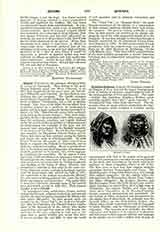

Quiche (UTLATECA), the principal aboriginal tribe or nation of Guatemala. They belong to the great Mayan linguistic stock (see Maya Indians), as do also their neighbors in the same state, the Cakchiquel, Pokonchi, and Tzutnhil, the four dialects constituting but one language. The Quiche occupied north-central Guatemala, including the present districts of Quiche, Totonicapan, and a part of Quezaltenango. Like those of the other Mayan tribes, their traditions pointed to a northern or northeastern origin, and their fairly authentic history went back to about A.D. 700. (Maya history seems fairly authentic as far back as the second century.) They were subjugated by Pedro de Alvarado about 1525, with even more than the customary atrocities, and rapidly declined under the system of slavery and heavy tribute imposed, notwithstanding the warnings of the pope and the humane laws promulgated by the Spanish monarch, at the instance of Las Casas. Even before the conquest was complete the Dominican Fathers Pontaz and de Torres had taken up their residence among the Quiche and begun the work of Christianization. In 1530 Father Francisco Marroquin (d. 1563) arrived from Spain to organize the Church in Guatemala, and in 1533 was confirmed as bishop. He gave special attention to the Indians and their languages, becoming particularly proficient in the Quiche, into which language he translated the catechism. On his appeal Father Las Casas (1536) established at Santiago a convent of Dominicans for the conversion of the natives. They were reinforced two years later by Fathers Zambrano and Dardon, of the Order of Mercy (Merced), who established a convent of that order in the same city. Under these two orders, working in harmony together with the Franciscans, who entered the field in 1541, the conversion of the Indians was gradually effected, the new converts being gathered into towns for their better government and instruction. The entire tribe is long since Christian, although many of the ancient rites and beliefs persist in daily life. Their present number is near 150,000.
In agricultural habit, architecture, literary method and productiveness, religious ceremonial and general culture, the ancient Quiche resembled the Maya, with only minor differences. In their genesis myth (as recorded in the “Popol Yuh”), the earth way brought into form by Gugumatz, the Plumed Serpent (equivalent to the Quetzalevatt of the Aztec), who finally created four men and four women, who became the ancestors of the race, assigning to each pair at the same time a special tutelary god, whose first duty it was to produce fire and light, to clear the world of evil monsters and to institute ceremonies and sacrifices.
The “Popol Vuh”, or “National Book”, the great literary monument of the Quiche, is a compendium of their ancient traditions handed down from before the conquest. The present version, evidently a copy from an older record, was written in the Quiche language by one of the tribe, apparently shortly after the conquest. It was first brought to attention through a Spanish translation by the Dominican Father Francisco Ximenez (c. 1725). In 1861 a more correct French translation, with the original text, was published in Paris by the Abbe Brasseur de Bourbourg. Of the work Brinton says: “This may well be considered one of the most valuable monuments of ancient American literature and its substantial authenticity cannot be doubted.”
JAMES MOONEY

